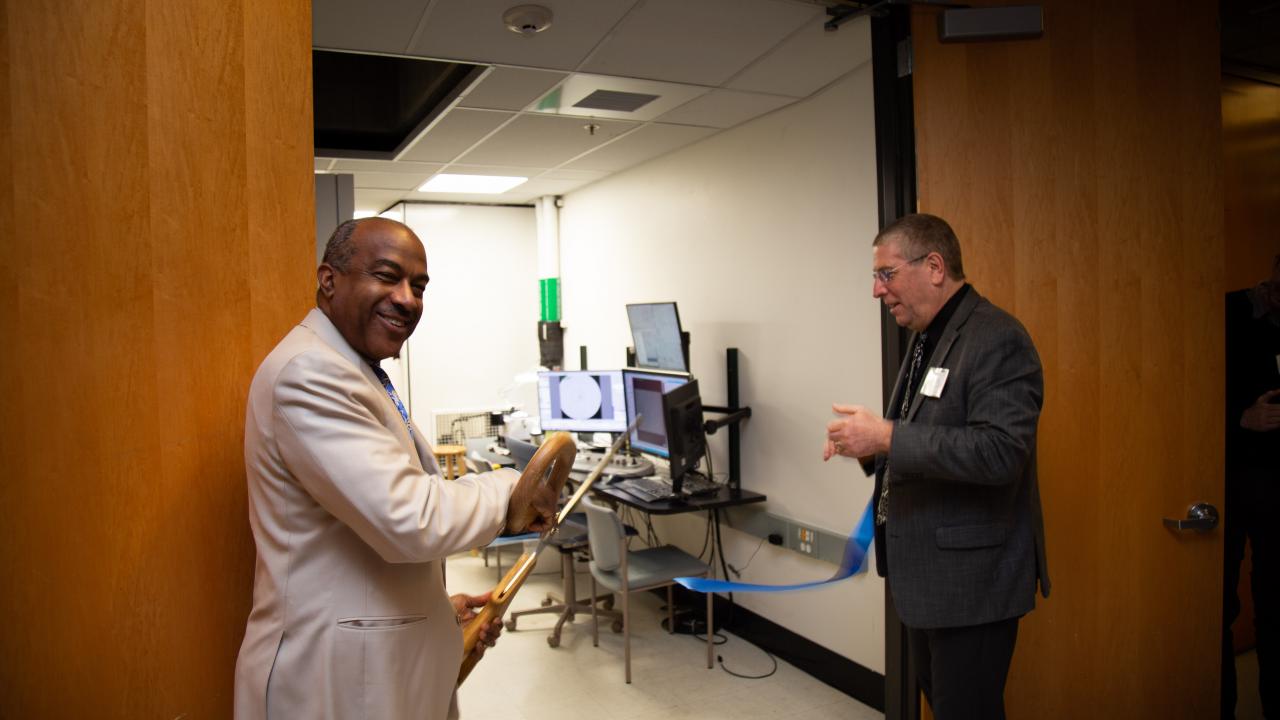
New Cryo-Electron Microscope Powers Biological Sciences Discovery
A new era in structural biology is coming to UC Davis, and it is already yielding discoveries.
It’s called cryoelectron microscopy, or cryo-EM, and it allows biologists to capture three-dimensional movies of biological molecules down to the scale of single atoms.
Chancellor Gary S. May and Mark Winey, dean of the College of Biological Sciences, recently cut the ribbon on a new cryo-EM facility in Briggs Hall. The $2.5 million microscope is open to all campus researchers. It can collect thousands of images a day to assemble into movies showing how proteins and other biomolecules do their work.
“Macromolecules like proteins and DNA are what we are made of,” said Enoch Baldwin, associate professor of molecular and cellular biology. “But most of the time we can only image them one at a time. What we really need to know is how they all fit together to drive the cellular machine.”
Cryo-EM works by rapidly cooling samples so that water around the proteins solidifies into a glassy state instead of forming ice crystals. It’s rather like looking at a fly trapped in amber, said Jawdat Al-Bassam, associate professor of molecular and cellular biology.
Proteins that have moving parts get stuck in all the different positions they can occupy. By collecting images of all these different conformations, researchers can put together a video that shows how a protein moves.
“Cryo-EM is a disruptive technology” — Jodi Nunnari
Until just a few years ago, the state-of-the-art technology for figuring out the structure of proteins and DNA was X-ray crystallography. This led to many breakthroughs — including the discovery of the DNA double helix itself. But it relies on building crystals made up of many identical molecules, so it is not useful for looking at areas of protein that change shape or move around.
“Cryo-EM is a disruptive technology; it answers so many of our outstanding question in biology,” said Jodi Nunnari, distinguished professor and chair of the Department of Molecular and Cellular Biology. “Having this technology on campus is a critical component to training modern-day biologists.”
Motor protein discovery
One recent example of major discovery from cryo-EM — coupled with other technologies — comes from Al-Bassam’s laboratory. The team showed how a protein called kinesin-5 is controlled as it slides microtubules past each other. This mechanism, essentially the same in organisms from yeast to humans, is a vital step in cell division and has been the target for experimental cancer drugs.
Kinesin-5 has a motor unit at one end that can move along a microtubule, and a rigid tail. It is found in tetramers — groups of four — Al-Bassam said. The tetramers are arranged with two motor units at each end so the protein can engage two microtubules and walk them in opposite directions, causing them to slide past each other.
Video: Cryo-EM reveals how kinesin-5 is controlled as it connects to microtubules
Tatyana Bodrug, an undergraduate student working in Al-Bassam’s lab, and colleagues used a series of techniques including cryo-EM to show that the kinesins are arranged nose-to-tail so each motor unit is in contact with the tail of another kinesin. The tails, they found, wedge open part of the motor that closes around the fuel molecule, ATP. This slows the movement of the motors, allowing kinesins to cluster and work together, generating more force on the microtubules.
If the tail is artificially removed, the motor walks faster along the tubule but with less force-generation.
“There is a seven-fold reduction in force capacity,” Al-Bassam said. “They have to walk slowly and work together to generate forces.”
Because microtubule sliding is so vital to cell division, kinesin is a primary target for drugs to treat a variety of cancers.
The kinesin motor protein was discovered more than 30 years ago by Jonathan Scholey, now professor emeritus in the Department of Molecular and Cellular Biology. Al-Bassam started working on kinesin after joining UC Davis in 2011 and talking to Scholey.
A paper describing the work was published online Jan. 20 in the journal eLife. Additional authors are: at UC Davis, Stanley Nithianantham, Pedro Gutierrez and Richard McKenney; Elizabeth Wilson-Kubalek and Ronald Milligan, Scripps Research Institute; Alex F. Thompson and Jason Stumpff, University of Vermont; April Alfieri, Ignas Gaska and Scott T. Forth, Rensselaer Polytechnic Institute; Jennifer Major and Steven Rosenfeld, Cleveland Clinic, Ohio and Mayo Clinic, Jacksonville, Florida; Sayaka Inagaki, Mayo Clinic, Jacksonville; Garret Debs and Charles Sindelar, Yale University; and Larisa Gheber, Ben-Gurion University of the Negev, Israel. The work was supported by grants from the NIH and NSF.
Media Resources
- Read the paper in eLife
- Press release: Revolutionary cryo-EM is taking over structural biology
- This story first appeared in Dateline
- Andy Fell, News and Media Relations, 530-752-4533, ahfell@ucdavis.edu
- Jawdat Al-Bassam, Molecular and Cellular Biology, (530) 752-3521, jawdat@ucdavis.edu
